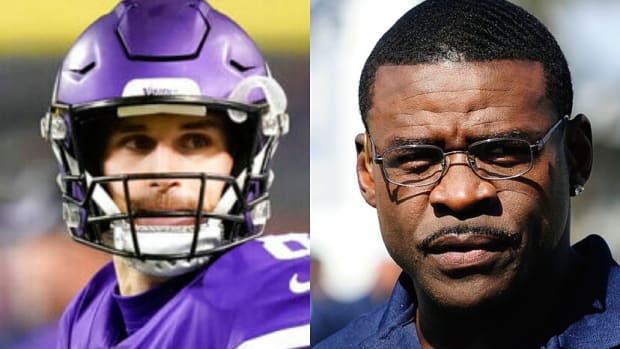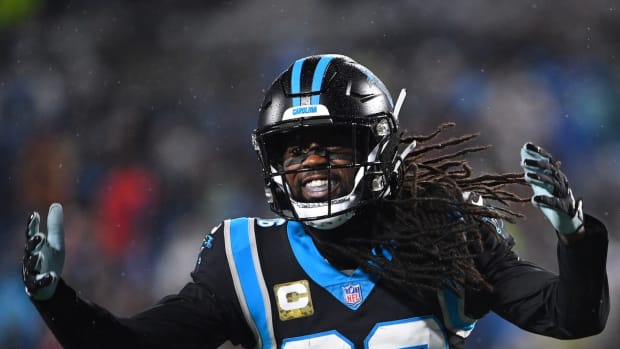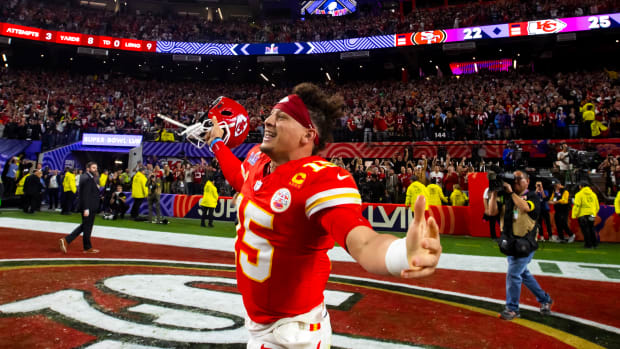Atlanta’s Defense Is One Step From Greatness: 10 Thoughts on the 2018 Falcons
As the NFL season approaches, Andy Benoit is previewing every NFL team in reverse order of last season’s finish. Up today: the Atlanta Falcons, who finished 10–6 and beat the Rams in the wild-card round before falling to the eventual-Super Bowl champion Eagles in the divisional round.
1. If not for allowing 31 points in their Monday night win over a Seahawks club that benefitted from Tyler Lockett’s great kickoff returns much of the game, the Falcons would have been the only NFL team last season to hold every opponent to under 27 points. That includes both of their playoff opponents, the Rams and Eagles, who finished first and third in scoring, respectively.
Quietly, this has become a very good defense. But, in Year 4 under Dan Quinn and with its nucleus having been in place for multiple seasons, it’s now to the point where anything short of greatness would be disappointing. Every level of this D has flashed before, but never have they all shined unceasingly.
In the secondary, corners Desmond Trufant and Robert Alford are bona fide stoppers, both on the perimeter and, when need be, in the slot. But they’ve also made just enough mistakes to keep from being elite. (For Alford, it’s penalties. For Trufant, at least last year, it was giving up big plays at a few untimely moments.) At linebacker, Deion Jones and De’Vondre Campbell look like the next Bobby Wagner and K.J. Wright, though they must become a tick more consistent at tackling and covering. (To be fair, Wagner and Wright are nearly flawless.) Up front, edge rusher Vic Beasley led the NFL with 15.5 sacks in 2016 but disappeared for stretches last year. As strictly a pass rushing specialist, he must bounce back. Opposite Beasley, 2017 first-rounder Takk McKinley came alive in the playoffs; can he blossom into a true three-down player?
The 2017 Falcons defense didn’t get gouged for points, but it also created an NFC-low 16 turnovers and couldn’t always get off the field. If the 2018 D is to elevate to Super Bowl caliber, it must generate more big plays.
2. Quinn runs a Seahawks-style Cover 3 zone scheme, though over the last two years he has incorporated significant snaps of man coverage. Either way, you hear all the time, Quinn’s system demands speed, especially at safety and linebacker. There are four reasons for this: 1) Like the old AT&T commercial said, “Faster is better than slower.” Simple. 2) Quinn’s zone coverages naturally concede a lot of space underneath. A defense offsets this by rallying to the ball. 3) Those same zone coverages can leave linebackers and safeties matched against wide receivers downfield. Those linebackers’ and safeties’ only prayer is to recognize the receiver’s route early and run. 4) Speed provides more freedom for man coverage assignments, which the Falcons took advantage of in 2017.
3. Some of Atlanta’s man coverage tendencies:
—They play it only when their secondary is close to fully healthy.
—They go man-robber against teams that run crossing patterns. Generally, in man-robber, one safety is deep and the other swoops across the middle.
—If they’re not blitzing, the Falcons prefer to match the speedier Deion Jones on a running back and the bigger De’Vondre Campbell on a tight end. (Though as Campbell has improved, these assignments have become more negotiable.)
—They’ll go “2 man,” playing both safeties back, which requires defenders to be more aggressive in their defined man assignments. Quinn tends to save these calls for crucial late situations. And because “2 man” is vulnerable to scrambles, he’ll often spy the quarterback, usually with Beasley.
4. The biggest mistake Gary Gramling and I made in our Top 10 Defensive Lineman podcast this offseason was not including Grady Jarrett. Yes, there are a ton of great defensive linemen right now. Jarrett is absolutely one of them. The fourth-year gap-penetrating maestro is quick with both his feet and his hands, and he amplifies it with sharp play recognition. Don’t be fooled by his low ’17 sack total (four). Jarrett is a tremendous force.
Ten People, Places and Things That Will Define the NFL in 2018
5. The only concern with this defense is questionable depth along the front four. Quinn prefers to rotate eight or nine D-linemen in highly specific packages. He might not have the resources for that in 2018. The Falcons must love rookie cornerback Isaiah Oliver; they had zero need at his position but still drafted him in Round 2, before any other defenders.
6. Despite ranking third in pass efficiency, eighth in run efficiency and first in third down efficiency, Atlanta’s offense averaged 11.7 fewer points per game in 2017 than in 2016. Schematically, it used the same ingredients as 2016, but those ingredients just didn’t produce meals as tasty. A bounceback is in the hands of chef Steve Sarkisian. Now with a year of NFL game-planning and play-calling under his belt, the offensive coordinator must find the run-pass harmony that his predecessor, Kyle Shanahan, mastered. Atlanta’s scheme is conducive to this. With an outside zone running game, a savvy veteran QB like Matt Ryan and scary outside receivers, throwing out of running looks comes naturally.
7. Sarkisian would help himself by putting running backs Devonta Freeman and Tevin Coleman on the field together. He did this in 2017, but only sparingly. It needs to happen 15 to 20 times a game. If there’s concern about overtaxing the star tailbacks, fourth-round rookie Ito Smith can assume a rotational role. Freeman and Coleman are both tremendous zone runners — Freeman with his vision and inside shiftiness, Coleman with his deceptive, long-striding speed. They’re potent together because either, or both, can flex out anywhere as a receiver. There’s no defensive package to counter this tandem. Go with three linebackers and you get thrown on. Employ a fifth defensive back and you get run on. Ryan is great going no-huddle. Imagine what he could do with these two flexible mismatch pieces and the entire 2:00 playbook at his disposal.
8. No play in football is more dangerous for defenses than Julio Jones catching a slant in stride. This is the crux of Atlanta’s play-action scheme. It’s imperative that the Falcons leverage it to help their ground game. Linebackers aren’t so quick to hit run-gaps when they’re worried about helping against the game’s most physically imposing receiver.
9. Left tackle Jake Matthews just got a contract extension. He has the athleticism to block in Atlanta’s outside zone ground game, and with his smooth footwork, the Falcons are often comfortable with him pass protecting one-on-one. But, big contract or not, five years into his career, you’d like the former No. 6 overall pick to be a tad more consistent.
Five NFL Storylines We Should Have Been Talking About This Summer
10. Right guard Wes Schweitzer got better down the stretch last season, which was critical since opponents were building their pass-rushing game plans around attacking him. Still, Schweitzer was this offense’s weak link, and a general manager’s job, at the core, is to fix weak links. So Thomas Dimitroff invested $12.75 million over three years in ex-49er/Viking Brandon Fusco (who, early in his career, was Minnesota’s version of Schweitzer). Schweitzer should stay focused, though. Left guard Andy Levitre is 32, has had some injuries and is in the final year of his contract. Schweitzer may very well be competing with sturdy backup Ben Garland for the other starting guard job in 2019.
Question or comment? Email us at talkback@themmqb.com.






































